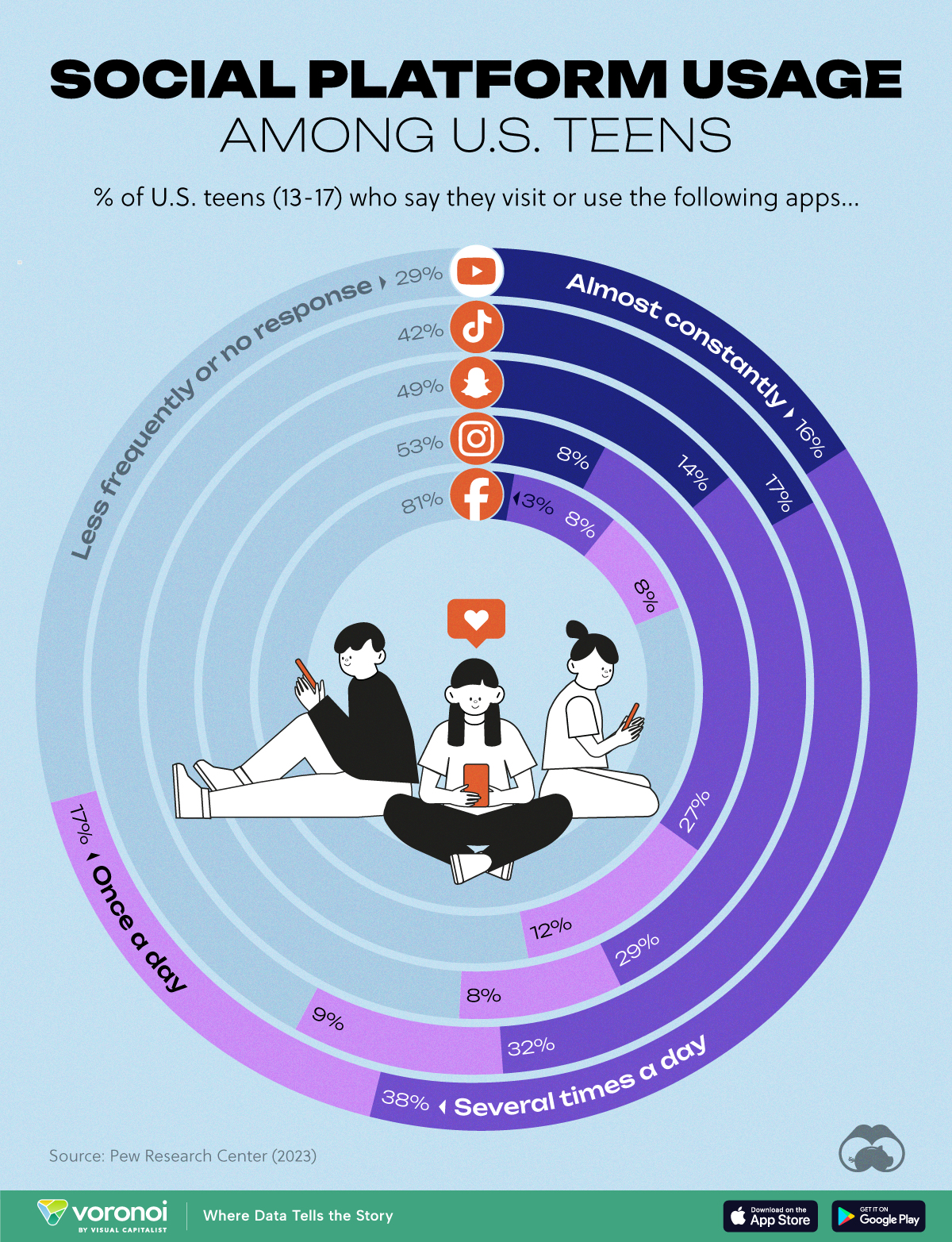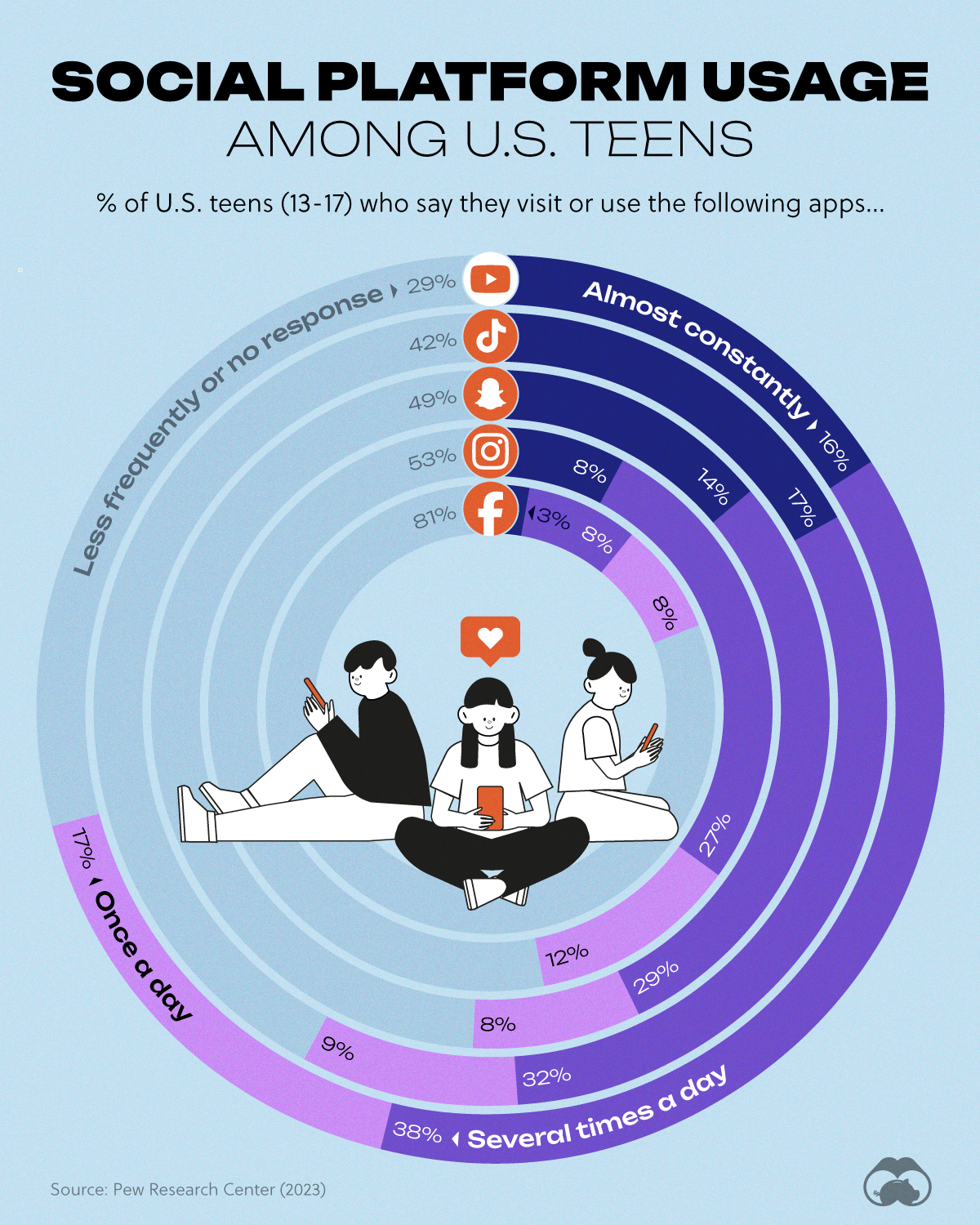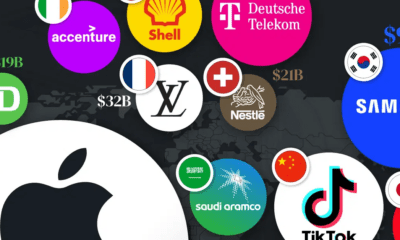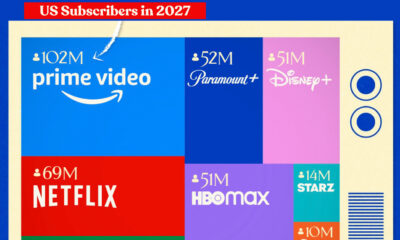Technology
Charted: Social Media Usage by U.S. Teenagers
![]() See this visualization first on the Voronoi app.
See this visualization first on the Voronoi app.
Charted: Social Media Usage by U.S. Teenagers
This was originally posted on our Voronoi app. Download the app for free on iOS or Android and discover incredible data-driven charts from a variety of trusted sources.
A majority of U.S. teenagers are daily users of video platforms. Short-form videos, in particular, have become very popular, as evidenced by TikTok’s rapid rise.
In this chart, we analyze social platform usage among U.S. teenagers (ages 13-17), based on data from a recent Pew Research Center survey conducted between September and October of 2023.
The Short Video Boom
YouTube continues to be the top platform among teens, followed by TikTok, Snapchat, and Instagram. On the other hand, Facebook is increasingly viewed as the “old person’s platform”, with only one in five teenagers using the platform daily.
Meanwhile, a similar proportion of teens say they’re on YouTube and TikTok “almost constantly”, with the majority visiting these platforms daily. The survey also shows that teen girls are far more likely than boys to say they use TikTok “almost constantly”.
| Platform | Almost constantly | Several times a day | Once a day | Less frequently* |
|---|---|---|---|---|
| YouTube | 16% | 38% | 17% | 29% |
| TikTok | 17% | 32% | 9% | 42% |
| Snapchat | 14% | 29% | 8% | 49% |
| 8% | 27% | 12% | 53% | |
| 3% | 8% | 8% | 81% |
*Includes no response.
95% of teenagers in the United States have access to a smartphone (usually an iPhone), and the vast majority of teens can also access these platforms through computers (90%) and gaming consoles (83%).
Black and Hispanic teens are more likely than white teens to say they are online almost constantly, according to the Pew Research Center survey.
The study also shows that intensive usage is independent of household income. The majority of teenagers who live in households making less than $30,000 per year and those in households making over $75,000 demonstrated heavy usage of social media platforms.
The time teenagers spend on social media has been a subject of debate in recent times.
According to UNICEF, excessive passive use of social media—simply scrolling through posts—can have detrimental effects on mental health. Research links this behavior to feelings of envy, inadequacy, and reduced life satisfaction. Some studies suggest it may even contribute to symptoms of ADHD, depression, anxiety, and sleep deprivation.
Technology
All of the Grants Given by the U.S. CHIPS Act
Intel, TSMC, and more have received billions in subsidies from the U.S. CHIPS Act in 2024.

All of the Grants Given by the U.S. CHIPS Act
This was originally posted on our Voronoi app. Download the app for free on iOS or Android and discover incredible data-driven charts from a variety of trusted sources.
This visualization shows which companies are receiving grants from the U.S. CHIPS Act, as of April 25, 2024. The CHIPS Act is a federal statute signed into law by President Joe Biden that authorizes $280 billion in new funding to boost domestic research and manufacturing of semiconductors.
The grant amounts visualized in this graphic are intended to accelerate the production of semiconductor fabrication plants (fabs) across the United States.
Data and Company Highlights
The figures we used to create this graphic were collected from a variety of public news sources. The Semiconductor Industry Association (SIA) also maintains a tracker for CHIPS Act recipients, though at the time of writing it does not have the latest details for Micron.
| Company | Federal Grant Amount | Anticipated Investment From Company |
|---|---|---|
| 🇺🇸 Intel | $8,500,000,000 | $100,000,000,000 |
| 🇹🇼 TSMC | $6,600,000,000 | $65,000,000,000 |
| 🇰🇷 Samsung | $6,400,000,000 | $45,000,000,000 |
| 🇺🇸 Micron | $6,100,000,000 | $50,000,000,000 |
| 🇺🇸 GlobalFoundries | $1,500,000,000 | $12,000,000,000 |
| 🇺🇸 Microchip | $162,000,000 | N/A |
| 🇬🇧 BAE Systems | $35,000,000 | N/A |
BAE Systems was not included in the graphic due to size limitations
Intel’s Massive Plans
Intel is receiving the largest share of the pie, with $8.5 billion in grants (plus an additional $11 billion in government loans). This grant accounts for 22% of the CHIPS Act’s total subsidies for chip production.
From Intel’s side, the company is expected to invest $100 billion to construct new fabs in Arizona and Ohio, while modernizing and/or expanding existing fabs in Oregon and New Mexico. Intel could also claim another $25 billion in credits through the U.S. Treasury Department’s Investment Tax Credit.
TSMC Expands its U.S. Presence
TSMC, the world’s largest semiconductor foundry company, is receiving a hefty $6.6 billion to construct a new chip plant with three fabs in Arizona. The Taiwanese chipmaker is expected to invest $65 billion into the project.
The plant’s first fab will be up and running in the first half of 2025, leveraging 4 nm (nanometer) technology. According to TrendForce, the other fabs will produce chips on more advanced 3 nm and 2 nm processes.
The Latest Grant Goes to Micron
Micron, the only U.S.-based manufacturer of memory chips, is set to receive $6.1 billion in grants to support its plans of investing $50 billion through 2030. This investment will be used to construct new fabs in Idaho and New York.
-

 Debt1 week ago
Debt1 week agoHow Debt-to-GDP Ratios Have Changed Since 2000
-

 Markets2 weeks ago
Markets2 weeks agoRanked: The World’s Top Flight Routes, by Revenue
-

 Countries2 weeks ago
Countries2 weeks agoPopulation Projections: The World’s 6 Largest Countries in 2075
-

 Markets2 weeks ago
Markets2 weeks agoThe Top 10 States by Real GDP Growth in 2023
-

 Demographics2 weeks ago
Demographics2 weeks agoThe Smallest Gender Wage Gaps in OECD Countries
-

 United States2 weeks ago
United States2 weeks agoWhere U.S. Inflation Hit the Hardest in March 2024
-

 Green2 weeks ago
Green2 weeks agoTop Countries By Forest Growth Since 2001
-

 United States2 weeks ago
United States2 weeks agoRanked: The Largest U.S. Corporations by Number of Employees
















